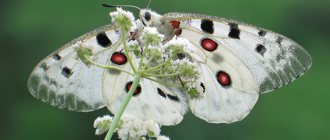- Wild animals
- >>
- Insects
The peacock butterfly has a very beautiful pattern on its wings, which is why it is sometimes even kept at home. She is unpretentious and tolerates captivity well if the conditions are suitable. In nature, it can be seen in almost any warm month, but they are much less common than urticaria or cabbage, especially in cities.
Origin of the species and description
Photo: Peacock butterfly
Lepidoptera appeared a very long time ago: in the early Jurassic period, almost two hundred million years BC. Gradually they developed, more and more species appeared, and they actively spread across the planet along with the spread of flowering plants across it.
During evolution, the formation of a proboscis occurred, they began to live more time in the form of an imago, and more and more species with large and beautiful wings appeared. The final formation of many modern species is attributed to the Neogene - at the same time the peacock eye appeared.
Video: Peacock butterfly
It is, along with approximately 6,000 other species, part of the large family of nymphalids. It looks similar to urticaria, which is not surprising, because they are in the same genus. His wings are the same black and orange tone, and stand out only with a brighter and more beautiful pattern.
The description was first made by Calus Linnaeus in 1759. Then it received the specific name Papilio io. Then it was replaced first by Inachis io - this name was taken from the mythology of Ancient Greece, and combined the name of King Inach and his daughter Io.
But ultimately, this symbolic combination had to be replaced with Aglais io in order to correctly determine the place of the species in the classification. There is also a night peacock eye, but this species is not closely related: it belongs to a different genus and even family.
Night representatives
The species has brothers with the similar name night peacock eye. But the consonance of names is where all the similarities between these butterflies end. They belong to different families, lead different lifestyles and are very different from each other in appearance. There are two nocturnal representatives - large and small.
Saturnia pear
The pear peacock eye, or Saturnia, is also called the greater night peacock eye. Its wingspan can reach 155 mm, and for this parameter it holds the record among European butterflies. Sometimes in the dark, a representative of the species is even confused with a bird or bat.
Saturnia's appearance is not very remarkable. The distinctive features are as follows:
- dark brown color of the upper side of the wings with a lightened leading edge and large black eye spots, inside of which blue scales with a white or blue border and reddish or black rings can be distinguished;
- massive body with thick hairs;
- long-feathered antennae in the male and comb-like in the female.
You can meet the peacock eye in forests, shrubby wastelands, parks, gardens, and fruit plantations. They fly at night, but sometimes males flying to the scent of pheromones from sedentary females can be seen during the day.
Small peacock eye
The small nocturnal peacock eye is similar in size to the daytime one, but the color of its wings is different . In males it is grayish-red, in females it is light gray. The pattern on the flying devices is formed by eye-shaped spots with a border in their center and transverse wavy lines. The body is heavily pubescent. The nocturnal lifestyle is typical for females; males can be active during the day.
Butterflies are found in the mountains at an altitude of up to 2 thousand meters, in sparse forests and on the outskirts of raised swamps. In some regions of Russia they are included in the local Red Books.
Butterflies are considered a symbol of happiness and immortality. Not only doves, but also these bright creatures can be released into the sky at weddings and other special events. But in this capacity, of course, it is better to use colorful daytime representatives.
Appearance and features
Photo: Night peacock butterfly
It is not difficult to distinguish butterflies from other butterflies; this can be done by the pattern on the wings - on each of them in the corner there is a yellow circle, inside of which there is another blue one. It really does look like an eye. The main color of the wing looks like hives; a rich orange tone predominates.
But the opposite side of the wings looks completely different: it is dark gray, almost black. This coloration makes the butterfly fly like a dry leaf and allows it to remain almost invisible to predators on tree trunks when it hibernates or simply rests and closes its wings.
Their span is larger than average - about 60-65 mm. They have a jagged outer edge with a light brown stripe running along it. The body is plump, like other types of urticaria, and has a developed oral apparatus with a proboscis.
The butterfly has compound eyes of a complex structure. There are six legs, but only four are used for walking, and the front pair is poorly developed. Sexual dimorphism is pronounced: females are much larger than males.
Interesting fact: The brightness of the butterfly's color is determined by how warm the weather was during pupation and development of the pupa. If it was cool, the wings will appear paler, and in very warm weather the shade will become especially saturated.
Now you know the difference between a daytime peacock butterfly and a night one. Let's see what the bright daytime butterfly eats and where it lives.
Where does the peacock butterfly live?
Photo: Day peacock butterfly
Over large areas, including almost all of Europe and most of Asia. These butterflies prefer temperate and subtropical climates, so they are easy to find in Russia, as well as in the rest of Eurasia, except for the tropical south and deserts, as well as the tundra.
Their concentration is especially high in Germany, and in Central Europe in general. They also live on many islands located around Eurasia, for example, in Japan. But not at all: for example, the peacock’s eye did not reach Crete. For some reason, these butterflies are not found in North Africa, despite the climate suitable for them.
Most often they can be found in forest clearings and garden plots - they love areas close to forests, but at the same time well lit by the sun and rich in flowers. They rarely fly into the thick of the forest because there is not enough sun there, and there is a risk of damaging the leaves by flying through too dense vegetation.
They can also live in moderately mountainous areas up to an altitude of 2,500 meters; they are no longer found higher. They love forest parks, and even more so city parks; they are found in gardens, clearings, as well as along the banks of lakes and rivers - in short, while walking in nature you can meet this butterfly even in the city. But their numbers are clearly orders of magnitude lower in comparison with the same urticaria.
Often the peacock eye migrates over long distances in order to find a more suitable habitat: they can fly tens and even hundreds of kilometers, although this takes them a lot of time - the butterfly cannot overcome a long distance at once, it needs to replenish its strength with nectar and rest, basking in the sun.
What does the peacock butterfly eat?
Photo: Peacock butterfly
Nectar from numerous plants.
Among them:
- sivets;
- elder;
- dandelion;
- thyme;
- thistle;
- marigold;
- felt burdock;
- clover;
- marjoram;
- and many others.
Most of all he loves buddleia. Nectar is the main and almost the only source of vitality for an adult butterfly, but in addition to it, the peacock’s eye is also attracted to tree sap - that’s why they can often be seen on trees drinking it.
Another drink they love is the juice of fermented fruits; it is often fed to butterflies in captivity, because it is relatively easy to obtain. To feed the butterfly, you can dilute honey or sugar in water - sometimes small pieces of fruit are also added to this solution. A butterfly in captivity needs to be fed daily.
For caterpillars, food plants are:
- nettle;
- hop;
- raspberries;
- willow;
- broom;
- hemp.
Interesting fact: A butterfly can overwinter in a warm room, but in this case its life processes will not slow down sufficiently and will be too active. As a result, she will either come out of hibernation already old and will fly for only a short time, or even die during hibernation.
Therefore, if there is a butterfly in your apartment in winter, you should carefully take it out and place it in a secluded place, for example, in the attic. Then her hibernation will go well.
Home content
The prevalence of the peacock eye is quite high; it can easily be found in clearings, meadows, forest edges, parks, gardens and river banks. It is useful for everyone to know about this butterfly, so even a child at school may be asked to prepare information about it in the form of a short story, message or report.
But sometimes the acquaintance with the butterfly occurs so closely that they decide to keep it at home. In order not to cause harm to the insect, you will have to care for it according to the following rules:
- Nutrition. The butterfly needs to be fed 1-2 times a day. As food, you can use nettle, raspberry, hop, willow or burdock leaves, as well as chopped bananas, oranges and other overripe fruits. A real treat for the butterfly will be natural honey diluted in water in a ratio of 1:10. You can use sugar instead of honey.
- Breeding. Butterflies can breed in captivity. To do this, the male and female need to be placed in a warm, spacious place with high humidity and good ventilation, where there is enough food and fresh leaves for laying eggs. Their mating can last from 30 minutes to 8 hours. If everything goes well, after a while caterpillars will appear, which will need to be fed with fresh grass. When pupating, they will have to be moved separately and hung upside down. You can place a wet towel nearby to increase air humidity.
- Wintering. The lifespan of an insect can be increased only by sending it into hibernation for the winter. To do this, you need to feed him, place him in a box with holes for ventilation and send him to a cool room where the temperature is in the range from 0 to 5 degrees Celsius. If the butterfly overwinters in a warm place, its life processes will not slow down enough, and it may grow old and die during hibernation.
Features of character and lifestyle
Photo: Daytime peacock butterfly
The adult form appears at the beginning of summer and enjoys life until September - more precisely, until the autumn cold arrives. These butterflies spend a significant part of their lives in flight, and it can be either active or passive - thanks to their wide wings, they save energy by simply gliding.
They are active only in the light of the sun - as soon as it starts to get cold in the evening, they look for a place to spend the night. They love sunlight and warmth very much, because they require a lot of energy to fly, so they can bask in the sun for a long time before starting their next flight.
They also need good weather to fly. Therefore, if rainy and cold periods in the summer drag on, the peacock’s eye enters diapause - the butterfly falls into a short summer hibernation. She usually spends up to a week in it and returns to active life immediately after it becomes warm and sunny again.
The peacock's eye is a real long-liver; in total, not counting periods of hibernation, it can live up to a year. After the onset of cold weather, it goes to wintering. It is noteworthy that in particularly warm areas, a peacock’s eye can overwinter a second time and wake up from hibernation again in the spring.
Thus, this butterfly can be found in the subtropics throughout most of the year - from March to October. Of course, in temperate latitudes this is much less likely; in the spring, only butterflies accidentally awakened by a thaw can be found, and they fly for only a short time.
Alas, death will probably await them, because a butterfly that wakes up ahead of time spends a lot of energy and cannot replenish it in the required amount - although sometimes it manages to find shelter and continue wintering in order to wake up again when it becomes really warm.
To overwinter, she needs to find a place where it will not be as cold as in the open air, but not warm either: she can climb under the bark of trees, deep into the forest floor, into balconies and attics. The main thing is that this place is protected from the cold and predators.
During hibernation, the butterfly can withstand freezing temperatures, although their exposure is undesirable. But she will not be able to react to the attack, nor will she be able to replenish her reserves of nutrients - so she needs to choose a secluded place and stock up on them in advance.
Social structure and reproduction
Photo: Pair of peacock butterflies
These butterflies live alone. When the breeding season begins, the males divide the territory among themselves, after which each one waits for the female to appear. When this happens, he begins a mating ritual, which includes flying together with mating dances. Butterflies also spread pheromones around themselves, which make it easier for them to find each other.
As a result, the female is fertilized and lays a hundred or several hundred eggs, almost always on a nettle. They take a week or two before the caterpillars emerge - faster in warm weather and longer in cold weather.
These insects are characterized by complete transformation. The first generation caterpillars appear in May, and the second in mid-summer. At first they remain in the brood, and when they grow up, they crawl away from each other and begin to live separately.
The caterpillars are dark in color and covered with long spines, although in reality they offer little protection from predators, but are designed to at least scare away some of them. The caterpillar really looks quite unapproachable, but predators are already accustomed to this species, although it can really have an effect on young and not particularly hungry ones.
In total, the peacock eye lives in the form of a caterpillar for about a month, and its main activity during this time is feeding. She chews the leaf almost continuously, and grows 20 times, her weight increasing even more. Then it pupates and spends 10-20 days in this form, depending on the weather - as in the case of the transformation from egg to larva, the warmer it is, the faster it passes this form.
The pupa can be attached to tree trunks, fences, walls; depending on the color of their surface, its color can also vary, mimicking its surroundings - it can be from light green to dark brown. The pupa, like the caterpillar, has spines.
When development ends, finally breaking the cocoon, the crown of the butterfly's development, the imago, its adult form, appears. She will need very little time to get used to the wings, after which she will be completely ready to fly.
Reproduction of pear peacock eye.
Saturnia pears are nocturnal moths. They fly from April to June in the evening twilight and at night. Females are less mobile: they mainly sit on branches and tree trunks. Males are more active, fly a lot, and can fly even during the day. Thanks to their long, sensitive antennae, males sense the female's pheromones over vast distances. Back in the 19th century, French entomologist Jean Henri Fabre found that a male Saturnia pear detects a female 10 km away, but if he is deprived of his antennae, this ability disappears.
Male. Photo by: Josef Dvořák
Female. Photo by: Josef Dvořák
An adult pear peacock eye butterfly does not feed, and the lifespan of a large night peacock eye is from 4-5 days to 2 weeks. Males live about 8 days, females - up to 20 days. After mating, female Great Night Peacocks search for a suitable location to lay eggs. They lay 250-410 eggs in a single layer in several piles or rows on thin branches or leaves of trees, which are suitable for further feeding of the caterpillars. In 24 hours, a female can lay up to 140 eggs, although by the end of her life this number is reduced to 2-3 eggs. Having laid all the eggs, the butterfly dies. The Saturnia fruit egg is white-gray in color and measures 2x2.5 mm.
Photo by: Tony Pittaway
Saturnia pear caterpillars hatch in 10-20 days. After hatching, they eat part of the shell of the egg in which they were located, and then actively eat the leaves of fruit trees: not only pears, but also apple trees, sloe trees, cherries, cherry plums, plums, and walnuts. Also, pear peacock eye caterpillars feed on the leaves of cherry, apricot, peach, quince, almond, currant, grape, blackthorn, olive, ash, elm, elm, linden, birch, poplar, alder, maple, plane tree and other deciduous plants. When emerging from eggs, the caterpillars are about 5-6 mm in size, but after feeding, they become very large: 9-10 cm long and as thick as an adult’s finger. The development of the caterpillar lasts 1.5-2 months, and its color changes throughout its life:
- When hatching from an egg, the pear peacock eye caterpillar is black or dark brown in color. Four rows of warts, from which long hairs protrude, are colored light brown.
Photo by: Enrico Ferrari
- In the second stage of development, warts become orange.
Photo by: Lubomír Klátil
- At the third stage, the caterpillar's body acquires a green-blue tint, the warts become yellow, and the head and anal segments become brown.
Photo by: Lubomír Klátil
- During the fourth stage of development, as well as adult caterpillars, they have a yellowish-green color and sky-blue warts, on which, in addition to hairs, spines filled with liquid appear. In addition, a long yellow stripe becomes clearly visible on the side of the body.
Photo by: Lubomír Klátil
- Before pupation, the caterpillar of the pear saturnia acquires a golden-brown color, due to which the blue warts look even more vibrant.
Photo credit: Fabio scardino, CC BY-SA 4.0
By the way, adult pear peacock eye caterpillars can squeak. By rubbing their jaws, they make sounds that precede the release of a special secretion that scares away potential enemies: birds and bats.
Pear peacock eye caterpillars actively feed from May to August, and around July-August they leave the tree crown, slide down the trunk and begin to cocoon. With the help of salivary glands, the caterpillar secretes special silk threads and wraps itself in them. Typically, cocoons are located in the root part of fodder trees, as well as between stones. Some cocoons can also be found attached to tree branches. The pear peacock eye cocoon is very dense, pear-shaped, brown, 35-50 mm long. Already in the cocoon, the caterpillar turns into a pupa. She spends the winter in this form.
Photo credit: Bejolino, CC BY-SA 3.0
The great night peacock eye produces only one generation per year. If the weather is not favorable and the spring and summer are cold, the pupa can overwinter again: thus, the species maintains the population without exposing itself to danger during the breeding season. Reactivation of the pupa requires a period of 120-140 days with temperatures ranging from 8 to 16 degrees Celsius. If the spring is warm, butterflies leave their cocoons, rise to some height to spread and dry their wings, and take off.
Photo by: Josef Dvořák
Natural enemies of peacock butterflies
Photo: Peacock butterfly
Butterflies have many enemies in all forms - they are in danger at any stage of life. Adult butterflies suffer less than others, but even they often die in the claws or beaks of predators.
They are hunted by:
- rodents;
- birds;
- large insects;
- reptiles.
It was to protect against these enemies that the peacock’s eye acquired such a bright color. It would seem that she does not help with this at all, on the contrary, she gives out a butterfly! In fact, when her wings are open, she is always alert and ready to fly away from a predator, but when she is resting, she closes them and merges with the bark of the trees.
If the predator nevertheless noticed her and attacked, she sharply opens her wings, and for a moment disorients him due to the sharp change in color - this brief moment is sometimes enough for salvation. Most often, butterflies die because of birds, which are much faster and capable of grabbing them even in flight. It is more difficult for other predators to do this, so all that remains is to lie in wait for them.
Caterpillars are hunted by the same predators as adults, and even more actively - caterpillars are more nutritious, and are also much less mobile, and certainly cannot fly away. Therefore, a significant number of them are exterminated - it is already a great success to survive to the cocoon, and even more so to the imago, since the pupa is even more defenseless.
As in the case of adults, caterpillars suffer most from birds, which love to fly into their clusters and eat dozens of them at once. But reptiles and rodents are not far behind: it is difficult for them to catch an adult butterfly, but a larva is a completely different matter. They are even threatened by ants, who, through coordinated actions, can kill a caterpillar that is much larger than them.
They still have ways to protect themselves from enemies: they can take a threatening pose, as if they are going to attack themselves, they begin to crawl in all directions, if they still live together - so at least part of them will survive, curl up into a ball and fall to the ground. They may also secrete a green liquid, designed to scare away predators.
What is the danger for this type of butterfly?
Due to its large size and nocturnal lifestyle, this butterfly species is not threatened by many pests. But while the butterfly is in the caterpillar stage of development, birds are the first enemy of this insect.
But, of course, humans pose a greater danger to such butterflies than birds. Here are the main types of human activities that can harm butterflies and their caterpillars:
- Spraying with insecticides and chemicals.
- Street lamps attract butterflies, and they fly into their light and burn their wings.
- Cutting down gardens and fruit trees.
It is worth noting that in other countries this species of moths is listed in the Red Book for protection. Previously, this butterfly was considered a pest, precisely because it ate foliage from fruit bushes and trees. But in our time, since the number of butterflies has decreased significantly, it cannot cause much harm to fruit plantings. The main feature of this insect is simply its beauty.











